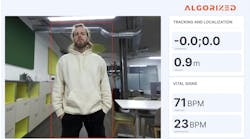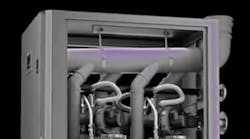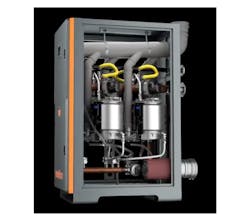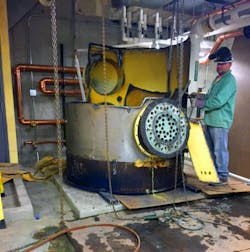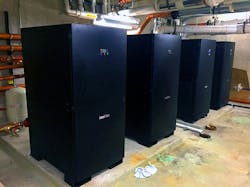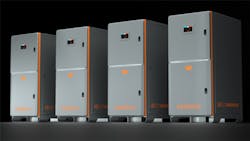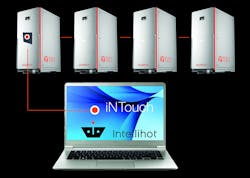Download this article in PDF format.
Designing commercial-scale water-heating systems that balance capacity with space, cost, and downtime may seem like a daunting task. It doesn’t have to be. When effectively applied, modular tankless systems can cut capital costs by 50%, operation costs by 40%, and space needs by 80%, while simultaneously quadrupling reliability.
Interior of a heat exchanger in Intellihot's tankless system.
People often ask if tankless technology can meet large-scale demand. How can one possibly deliver up to 1.5 million BTUs without storage tanks? Below you will find an inside technical look into a radical engineering approach. As technology becomes more intelligent, some water heaters can learn the recirculation patterns and demands of a building. Then they would be able to automatically power on pumps and set the temperature to minimize cost without losing comfort. Here’s how it all works.
Pressure Drop
Have you driven a Prius? Imagine driving a battery-powered vehicle. Now, take your foot off the brake. Does the vehicle move? Technically, it shouldn’t move at all until you press the accelerator. However, as soon as you take your foot off the brake, the vehicle starts to creep forward, much like a gas-powered car. The reason that Toyota did this is because they want you to “feel” like you are driving a regular gas-fueled car with an automatic transmission.
Similarly, tankless water heaters can be built to mimic the typical pressure drop curve of a tank water heater, so it has zero pressure drop allowing the flow to “feel” like that of a tank water heater. Commercial buildings have a fairly complex hydraulic layout and miles of piping. So it is critical that replacement units have a similar hydraulic performance.
An old water heater being decommissioned and replaced with a tankless hot water heater.
The decommissioned tank was replaced with this system. The modular units allow for failsafe, robust operation.
There are two ways to curve shape a pressure-drop profile. The first method involves using a single-speed, less-costly, constant-speed pump that can create a very large pressure rise at lower flows. During these lower flows, the flow into at least one of the heat exchangers is restricted via a flow valve. The net result is called “curve shaping” of the pressure drop to mimic the typical pressure-drop curve of a tank water heater.
The second method involves using a variable-speed pump to continuously increase speed/pressure from a low to a higher flow, thus again “curve shaping” the pressure drop to mimic the pressure-drop curve of a tank water heater. In both cases, if a demand is greater than the flow rate the pump can provide to the heat exchangers, the required flow is met by increasing the flow via the bypass line, again effecting a low pressure loss.
Tank-like Pressure Drop
Tankless water heaters are now capable of achieving a real-time tank-like pressure drop that makes the sensitive components in a large building such as circulation pumps, pressure-reducing valves, variable-frequency drives (VFDs), etc., “unaware” that they are operating on a tankless water heater. This means installation is truly drop-in. It eliminates the need to rebalance the building, and it allows a tankless heater to be applied to any building, big or small, from high rises to schools to hotels.
Masterless Cascading, Built-in Modularity
Think of each tankless module as a robot. Each unit contains multiple heat engines, and each heat engine operates autonomously. All of the heat engines in a unit or multiple connected units work together.
This radical approach allows for near 100% up-time, even if one or two heat engines are down. It is achieved by reinventing basic communication between the heat engines and doing away with the traditional master-slave control approach.
Each module or heat engine is always in peer-to-peer communication with others in the chain, and together they decide by rotation how to handle error codes, or how to meet the ever-changing demands of hot water. This masterless cascading feature eliminates single point failures.
This is an example of a masterless cascading system from Intellihot.
It is possible to achieve a very high degree of failsafe reliability through a combination of modular devices, control strategies like masterless, and having devices automatically rotate and isolate themselves. For example, if six heat engines are running and one drops off the chain, it will communicate to the remaining five to take over its load. The other engines regroup and continue running. With five out of the six heat engines still running, you have almost 90% heating capability.
Our draw profile analyses have shown that water heaters operate on full load for barely an hour or two a day. So, if you have 90% capacity, it really means you’re good for 23 out of 24 hours in a day, which allows you to schedule service and maintenance calls during off-peak hours.
Self-Learning Usage Patterns, Smart Building Management System (BMS)
Built-in, smart logic and self-learning capabilities are available. Tankless units can observe hot-water usage patterns and store these data points over time. Data is used to identify the best times to power the recirculation pumps on and off, and to automatically control the building’s set-point temperature. This is made possible due to a next-generation BMS that has the ability to connect with the pumps in a building to turn them on and off based on actual usage patterns. This saves on energy and cost without sacrificing performance.
Here’s a representation of Intellihot’s iNTouch building management system.
The ability to control the recirculation pumps and modify set-point temperature based on self-learned, real-time usage patterns is a true breakthrough. This is not your grandpa’s BMS! The ability to set the temperature and control louvers may be standard, but some BMS currently on the market have the ability to control recirculation pumps and set-point temperature. In addition, it is possible to detect problems with connected components and alert users which component needs attention.
What to Look for in a Tankless Heat Exchanger
A tankless heat exchanger should have the following features:
• Few or no joints on the water side of the tankless exchanger. This reduces cracking and corrosion (materials like stainless steel also will help with corrosion).
• Robust design: Remember this exchanger will go through many and often rapid thermal cycles, so strong materials with high tolerance for thermal fatigue will be important.
• Ability to address build-up: Some heat exchangers vibrate to keep lime in suspension, reducing or eliminating lime scale build-up. Otherwise, this can reduce a heater's ability to be effective over time.
Elimination of Mixing Valves, High Temperature Storage, and Legionella
Prevailing commercial water-heating systems either require storage tanks or that they store a certain quantity of water in the heat exchangers. As a result, they necessitate keeping water at a higher temperature to mitigate legionella growth (Legionnaires’ disease). In turn, the higher temperature necessitates deploying mixing valves and two sets of high/low temperature piping in the water-distribution system. This type of system is notoriously unreliable.
Since tankless units have no storage at all, they are able to eliminate legionella growth. Finding a heavy-duty commercial tankless heater that does not require mixing valves can create a more efficient system. Installing units without mixing valves will save capital expenditure, reduce complexity, and eliminate the unreliability associated with mixing valves.







